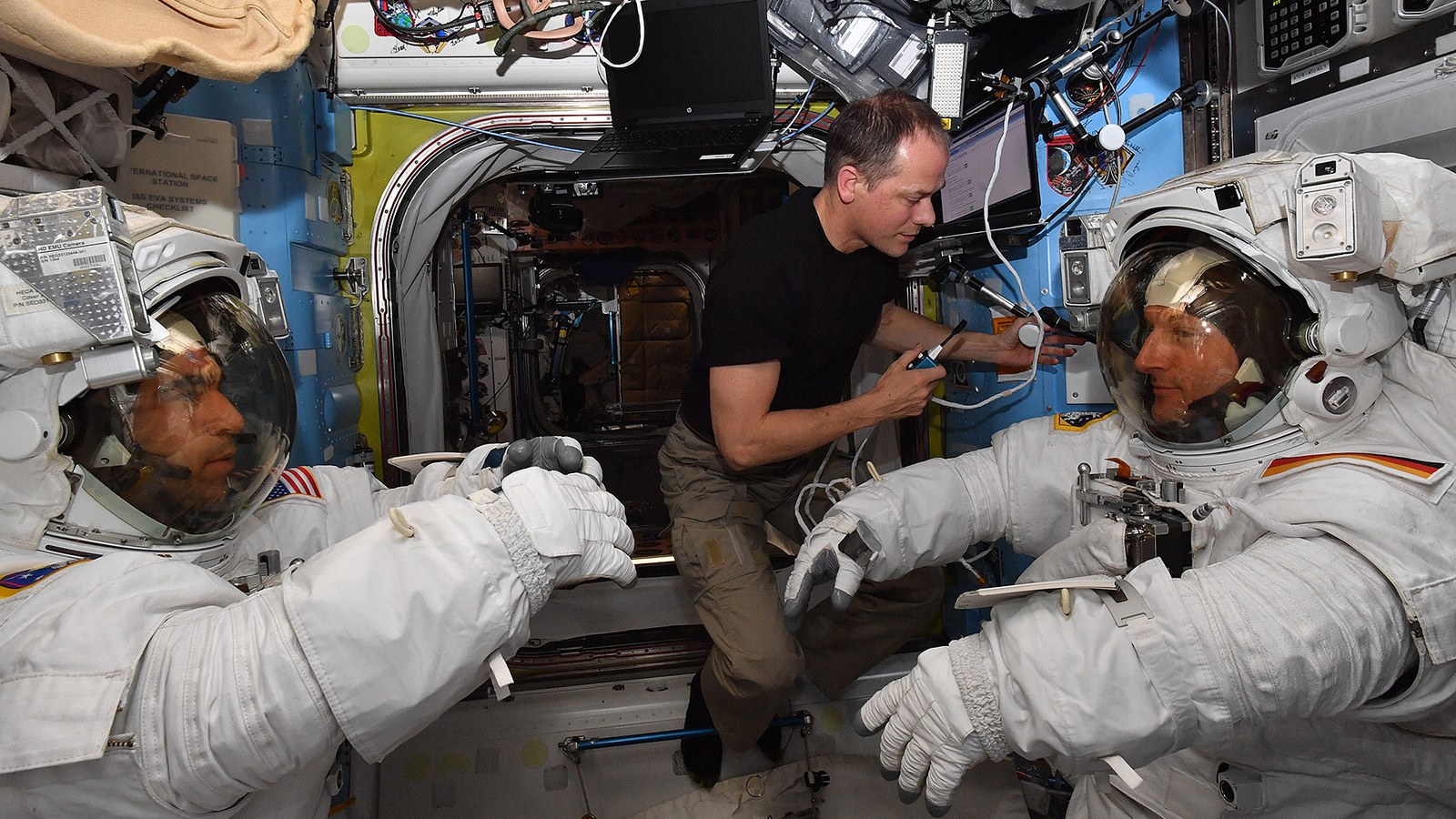Demanding work with a breathtaking view



- On 23 March 2022, Matthias Maurer, a German astronaut in the European Space Agency (ESA) astronaut corps, will complete his first mission on the exterior of the International Space Station ISS.
- Matthias Maurer and NASA colleague Raja Chari will work for six and a half hours outside the ISS, carrying out final work on the commercial Bartolomeo payload platform.
- DLR is involved in Matthias Maurer's Cosmic Kiss mission in a variety of ways.
- Focus: Space, Cosmic Kiss
The opening of the hatch on the US Quest airlock of the International Space Station ISS on 23 March 2022 at 13:55 CET will mark the start of the most challenging task of German astronaut Matthias Maurer's six-month 'Cosmic Kiss' mission. The 52-year-old materials scientist from St. Wendel in Saarland will conduct an extravehicular activity (EVA) and NASA colleague Raja Chari that will last approximately six and a half hours. The two will be easy to distinguish visually: Matthias Maurer will be in the all-white 'EV-2' suit, while Raja Chari will wear the 'EV-1' with the red stripe. US EVA 80 is the 248th EVA in ISS history and will be broadcast live by NASA TV from 13:55 CET.
Hard work under low (air) pressure
"Matthias Maurer is the fourth German astronaut to complete an EVA, after Thomas Reiter, Hans Schlegel and Alexander Gerst," explains Volker Schmid, manager of Maurer's Cosmic Kiss mission at the German Space Agency at the German Aerospace Center (Deutsches Zentrum für Luft- und Raumfahrt; DLR). "This is certainly no walk in the park, but rather a precisely planned and extremely physically demanding mission. Hard work with a wonderful view awaits Matthias." Space is predominantly a vacuum. The pressure tends towards zero.
"But our bodies need air. That's why an air pressure of about one bar is maintained in the Space Station, which corresponds to the normal pressure on Earth at sea level," explains Daria Margiotta, Flight Director for the Cosmic Kiss mission at the Columbus Control Centre, located at the DLR site in Oberpfaffenhofen. That's why the US spacesuit worn by Maurer during his EVA must also be pressurised, but still providing an environment that allows astronauts to move around. "The air pressure in the suit is reduced to about a third of a bar. Nevertheless, the astronauts still have to work against the remaining stiffness of the suit’s arms, fingers and legs to perform their tasks outside the ISS," adds Margiotta.
Plugging into commercialisation
What tests await the two astronauts on their six-and-a-half 'field trip' outside the ISS? Their main task is to repair part of the Space Station's cooling system. To do this, they will install new hoses on one of the system's valve modules, which regulates the temperature inside the ISS by passing ammonia through the Station's heat exchangers. They will also replace an external camera on the Station's large boom structure, on which the solar arrays are also mounted, and upgrade other hardware.
"From a German perspective, Matthias Maurer is also performing another extremely important task," emphasises Schmid. "He will make the commercial Bartolomeo external platform on ESA's Columbus module ready for operation by installing the last missing power and data cable, thus fully connecting the platform to the ISS." Margiotta adds: "One day after Maurer's EVA, we will activate Bartolomeo from the Columbus Control Centre in Oberpfaffenhofen and support the Bartolomeo Control Centre in Bremen in completing the commissioning phase in the following two weeks."
More space on the Station thanks to technology 'made in Germany'
With Bartolomeo, the ISS is entering a new era. "The project, which was developed in Germany, will drive the commercialisation of the Space Station. Bartolomeo, as Europe's first private external platform on the ISS, now offers companies and research institutions the unique opportunity to advance their project more easily and quickly in space," says a delighted Schmid. With help from Maurer's EVA, the two-by-two-and-a-half-metre, 484-kilogram platform named after the younger brother of Christopher Columbus – explorer and namesake of the European ISS laboratory – will expand the available space on the ISS by 12 experiment and three antenna slots. The payloads can be around half a cubic metre in size and enjoy an unobstructed view of Earth or space from an altitude of approximately 400 kilometres.
Variety of experiments guaranteed
Bartolomeo is therefore particularly suitable for experiments that require a 'free' space environment. "Radiation biologists, astrophysicists and solar physicists, Earth observers and atmospheric or climate researchers in particular will benefit from this platform," says Schmid. "Bartolomeo is also particularly suitable for technology testing and validation. On the ISS, and thus on Bartolomeo, there are unique possibilities that cannot be achieved in any laboratory on Earth, and which allow optical sensors, materials, robotic components and antennas to be tested in a real space environment." Several payloads are currently in the works for Bartolomeo, which are scheduled for deployment in early 2023. These are various biology, materials and radiation experiments, cameras and sensors for technology testing and measuring various environmental parameters. Experiments on high-precision clocks and laser communications are also planned. The platform was built by Airbus in Bremen and is to be operated jointly with the Columbus Control Centre at the DLR site in Oberpfaffenhofen.
